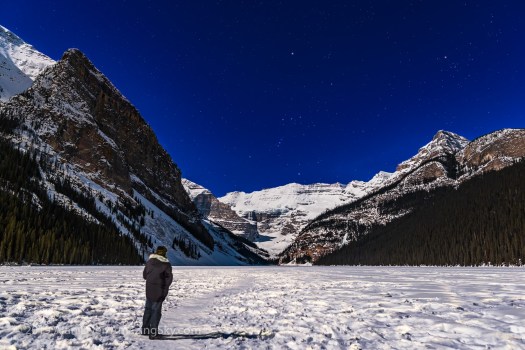
For two magical nights I was able to capture the Rockies by moonlight, with the brilliant stars of winter setting behind the mountains.
I’ve been waiting for nights like these for many years! I consider this my “25-Year Challenge!”
Back during my early years of shooting nightscapes I was able to capture the scene of Orion setting over Lake Louise and the peaks of the Continental Divide, with the landscape lit by the Moon.
Such a scene is possible only in late winter, before Orion sets out of sight and, in March, with a waxing gibbous Moon to the east to light the scene but not appear in the scene. There are only a few nights each year the photograph is possible. Most are clouded out!

Above is the scene in March 1995, in one of my favourite captures on film. What a night that was!
But it has taken 24 years for my schedule, the weather, and the Moon phase to all align to allow me to repeat the shoot in the digital age. Thus the Challenge.
Here’s the result.

Unlike with film, digital images make it so much easier to stitch multiple photos into a panorama.
In the film days I often shot long single exposures to produce star trails, though the correct exposure was an educated guess factoring in variables like film reciprocity failure and strength of the moonlight.
Below is an example from that same shoot in March 1995. Again, one of my favourite film images.

This year, time didn’t allow me to shoot enough images for a star trail. In the digital age, we generally shoot lots of short exposures to stack them for a trail.
Instead, I shot this single image of Orion setting over Mt. Temple.

Plus I shot the panorama below, both taken at Morant’s Curve, a viewpoint named for the famed CPR photographer Nicholas Morant who often shot from here with large format film cameras. Kevin Keefe of Trains magazine wrote a nice blog about Morant.
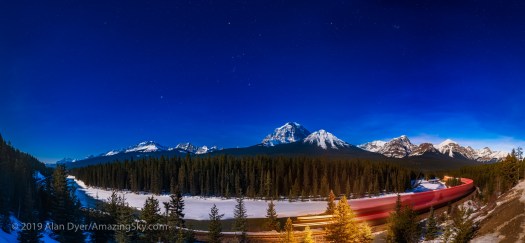
I was shooting multi-segment panoramas when a whistle in the distance to the west alerted me to the oncoming train. I started the panorama segment shooting at the left, and just by good luck the train was in front of me at centre when I hit the central segment. I continued to the right to catch the blurred rest of the train snaking around Morant’s Curve. I was very pleased with the result.
The night before I was at another favourite spot, Two Jack Lake near Banff, to again shoot panoramas of the moonlit scene below the bright stars of the winter sky.
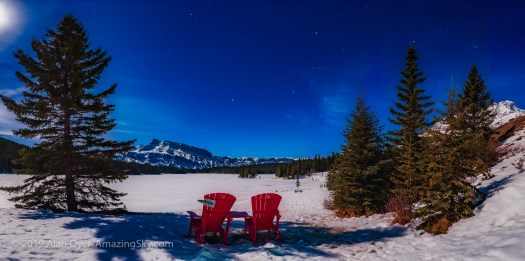
A run up to the end of the Vermilion Lakes road at the end of that night allowed me to capture Orion and Siris reflected in the open water of the upper lake.

Unlike in the film days, today we also have some wonderful digital planning tools to help us pick the right sites and times to capture the scene as we envision it.
This is a screen shot of the PhotoPills app in its “augmented reality” mode, taken by day during a scouting session at Two Jack, but showing where the Milky Way will be later that night in relation to the real “live” scene shot with the phone’s camera.

The app I like for planning before the trip is The Photographer’s Ephemeris. This is a shot of the plan for the Lake Louise shoot. The yellow lines are the sunrise and sunset points. The thin blue line at lower right is the angle toward the gibbous Moon at about 10 p.m. on March 19.

Even better than TPE is its companion program TPE 3D, which allows you to preview the scene with the mountain peaks, sky, and illumination all accurately simulated for your chosen location. I am impressed!
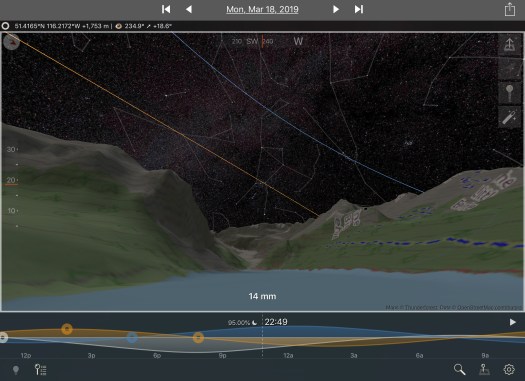
Compare the simulation above to the real thing below, in a wide 180° panorama.

These sort of moonlit nightscapes are what I started with 25 years ago, as they were what film could do well.
These days, everyone chases after dark sky scenes with the Milky Way, and they do look wonderful, beyond anything film could do. I shoot many myself. And I include an entire chapter in my ebook above about shooting the Milky Way.
But … there’s still a beauty in a contrasty moonlit scene with a deep blue sky from moonlight, especially with the winter sky and its population of bright stars and constellations.
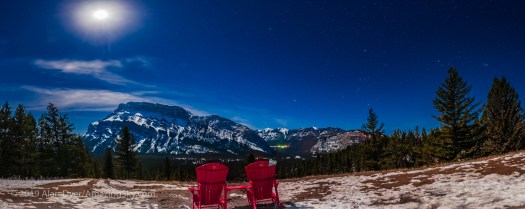
I’m glad the weather and Moon finally cooperated at the right time to allow me to capture these magical moonlit panoramas.
— Alan, March 26, 2019 / © 2019 Alan Dyer / AmazingSky.com


What glorious Earth and sky! Thanks for explaining your strategy using the scenes’ illumination from the out of frame Moon. It makes me appreciate your preparation, planning, timing and readiness even more.
Pretty crafty to have both Sirius & Rigel just visible off the slopes of the mountains.
Thanks Alan for sharing!!!
Thank you for always sharing your beautiful pictures. God’s glory is revealed in each one.
Truly magnificent Alan thanks for sharing such beauty of this world and universe